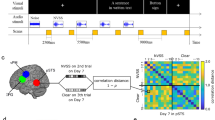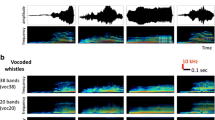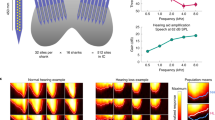Abstract
Cochlear implants provide good speech discrimination ability despite highly limited amount of information they transmit compared with normal cochlea. Noise vocoded speech, simulating cochlear implants in normal hearing listeners, have demonstrated that spectrally and temporally degraded speech contains sufficient cues to provide accurate speech discrimination. We hypothesized that neural activity patterns generated in the primary auditory cortex by spectrally and temporally degraded speech sounds will account for the robust behavioral discrimination of speech. We examined the behavioral discrimination of noise vocoded consonants and vowels by rats and recorded neural activity patterns from rat primary auditory cortex (A1) for the same sounds. We report the first evidence of behavioral discrimination of degraded speech sounds by an animal model. Our results show that rats are able to accurately discriminate both consonant and vowel sounds even after significant spectral and temporal degradation. The degree of degradation that rats can tolerate is comparable to human listeners. We observed that neural discrimination based on spatiotemporal patterns (spike timing) of A1 neurons is highly correlated with behavioral discrimination of consonants and that neural discrimination based on spatial activity patterns (spike count) of A1 neurons is highly correlated with behavioral discrimination of vowels. The results of the current study indicate that speech discrimination is resistant to degradation as long as the degraded sounds generate distinct patterns of neural activity.







Similar content being viewed by others
References
Anderson SE, Kilgard MP, Sloan AM, Rennaker RL (2006) Response to broadband repetitive stimuli in auditory cortex of the unanesthetized rat. Hearing Res 213:107–117
Beitel RE, Vollmer M, Raggio MW, Schreiner CE (2011) Behavioral training enhances cortical temporal processing in neonatally deafened juvenile cats. J Neurophysiol 106:944–959
Boemio A, Fromm S, Braun A, Poeppel D (2005) Hierarchical and asymmetric temporal sensitivity in human auditory cortices. Nat Neurosci 8:389–395
Britten KH, Shadlen MN, Newsome WT, Movshon JA (1992) The analysis of visual motion: a comparison of neuronal and psychophysical performance. The J of neurosci: the Off J of the Soc for Neurosci 12:4745–4765
Buonomano DV, Merzenich MM (1995) Temporal information transformed into a spatial code by a neural-network with realistic properties. Science 267:1028–1030
Buonomano DV, Merzenich M (1999) A neural network model of temporal code generation and position-invariant pattern recognition. Neural Comput 11:103–116
Christensen TA, Antonucci SM, Lockwood JL, Kittleson M, Plante E (2008) Cortical and subcortical contributions to the attentive processing of speech. Neuroreport 19:1101–1105
Cunningham J, Nicol T, King C, Zecker SG, Kraus N (2002) Effects of noise and cue enhancement on neural responses to speech in auditory midbrain, thalamus and cortex. Hearing Res 169:97–111
Davis MH, Johnsrude IS (2003) Hierarchical processing in spoken language comprehension. J of Neurosci J Soc Neurosci 23:3423–3431
Delgutte B, Kiang NY (1984) Speech coding in the auditory nerve: I. Vowel-like sounds. J Acoust Soc Am 75:866–878
Dorman MF, Loizou PC (1997) Speech intelligibility as a function of the number of channels of stimulation for normal-hearing listeners and patients with cochlear implants. Am J Otol 18:S113–S114
Dorman MF, Loizou PC, Fitzke J, Tu Z (1998) The recognition of sentences in noise by normal-hearing listeners using simulations of cochlear-implant signal processors with 6–20 channels. J Acoust Soc Am 104:3583–3585
Drullman R, Festen JM, Plomp R (1994) Effect of temporal envelope smearing on speech reception. J Acoust Soc Am 95:1053–1064
Engineer CT, Perez CA, Chen YTH, Carraway RS, Reed AC, Shetake JA, Jakkamsetti V, Chang KQ, Kilgard MP (2008) Cortical activity patterns predict speech discrimination ability. Nat Neurosci 11:603–608
Fishman KE, Shannon RV, Slattery WH (1997) Speech recognition as a function of the number of electrodes used in the SPEAK cochlear implant speech processor. J Speech Lang Hear R 40:1201–1215
Foffani G, Moxon KA (2004) PSTH-based classification of sensory stimuli using ensembles of single neurons. J Neurosci Meth 135:107–120
Gatehouse S (1992) The time course and magnitude of perceptual acclimatization to frequency responses: evidence from monaural fitting of hearing aids. J Acoust Soc Am 92:1258–1268
Grady CL, Van Meter JW, Maisog JM, Pietrini P, Krasuski J, Rauschecker JP (1997) Attention-related modulation of activity in primary and secondary auditory cortex. Neuroreport 8:2511–2516
Green DM, Swets JA (1989) Signal detection theory and psychophysics. Los Altos, CA: Peninsula Publishing
Hedrick MS, Carney AE (1997) Effect of relative amplitude rind formant transitions on perception of place of articulation by adult listeners with cochlear implants. J Speech Lang Hear R 40:1445–1457
Hugdahl K, Thomsen T, Ersland L, Rimol LM, Niemi J (2003) The effects of attention on speech perception: an fMRI study. Brain Lang 85:37–48
Hughes ML, Vander Werff KR, Brown CJ, Abbas PJ, Kelsay DM, Teagle HF, Lowder MW (2001) A longitudinal study of electrode impedance, the electrically evoked compound action potential, and behavioral measures in nucleus 24 cochlear implant users. Ear Hear 22:471–486
Kawahara H (1997) Speech representation and transformation using adaptive interpolation of weighted spectrum. IEEE Trans Acoust Speech Sig Process 2:1303–1306
Kiefer J, von Ilberg C, Rupprecht V, Hubner-Egner J, Knecht R (2000) Optimized speech understanding with the continuous interleaved sampling speech coding strategy in patients with cochlear implants: effect of variations in stimulation rate and number of channels. Ann Otol Rhinol Laryngol 109:1009–1020
Kilgard MP, Merzenich MM (1998) Cortical map reorganization enabled by nucleus basalis activity. Science 279:1714–1718
Kral A (2007) Unimodal and cross-modal plasticity in the ‘deaf’ auditory cortex. Int J Audiol 46:479–493
Kral A, Tillein J (2006) Brain plasticity under cochlear implant stimulation. Adv Otorhinolaryngol 64:89–108
Kral A, Tillein J, Heid S, Klinke R, Hartmann R (2006) Cochlear implants: cortical plasticity in congenital deprivation. Prog Brain Res 157:283–313
Krueger B, Joseph G, Rost U, Strauss-Schier A, Lenarz T, Buechner A (2008) Performance groups in adult cochlear implant users: speech perception results from 1984 until today. Otol Neurotol 29:509–512
Kumar A, Rotter S, Aertsen A (2010) Spiking activity propagation in neuronal networks: reconciling different perspectives on neural coding. Nat Rev Neurosci 11:615–627
Liu J, Newsome WT (2005) Correlation between speed perception and neural activity in the middle temporal visual area. The Journal of neuroscience: the official journal of the Society for Neuroscience 25:711–722
Loebach JL, Wickesberg RE (2006) The representation of noise vocoded speech in the auditory nerve of the chinchilla: physiological correlates of the perception of spectrally reduced speech. Hearing Res 213:130–144
Loizou PC (1998) Mimicking the human ear. Ieee Signal Proc Mag 15:101–130
Loizou PC (2006) Speech processing in vocoder-centric cochlear implants. Adv Otorhinolaryngol 64:109–143
Loizou PC, Dorman M, Tu ZM (1999) On the number of channels needed to understand speech. J Acoust Soc Am 106:2097–2103
Loizou PC, Poroy O, Dorman M (2000) The effect of parametric variations of cochlear implant processors on speech understanding. J Acoust Soc Am 108:790–802
Mauk MD, Buonomano DV (2004) The neural basis of temporal processing. Annu Rev Neurosci 27:307–340
Moore DR, Shannon RV (2009) Beyond cochlear implants: awakening the deafened brain. Nat Neurosci 12:686–691
Nie K, Barco A, Zeng FG (2006) Spectral and temporal cues in cochlear implant speech perception. Ear Hear 27:208–217
Ohl FW, Scheich H (1997) Orderly cortical representation of vowels based on formant interaction. P Natl Acad Sci U S A 94:9440–9444
Panzeri S, Brunel N, Logothetis NK, Kayser C (2010) Sensory neural codes using multiplexed temporal scales. Trends Neurosci 33:111–120
Perez CA, Engineer CT, Jakkamsetti V, Carraway RS, Perry MS, Kilgard MP (2012) Different time scales for the neural coding of consonant and vowel sounds. New York, NY: Cereb Cortex
Peterson G, Barney H (1952) Control methods used in a study of the vowels. J Acoust Soc Am 24:175–183
Poeppel D (2003) The analysis of speech in different temporal integration windows: cerebral lateralization as ‘asymmetric sampling in time’. Speech Commun 41:245–255
Rao D, Basura GJ, Roche J, Daniels S, Mancilla JG, Manis PB (2010) Hearing loss alters serotonergic modulation of intrinsic excitability in auditory cortex. J Neurophysiol 104:2693–2703
Rennaker RL, Carey HL, Anderson SE, Sloan AM, Kilgard MP (2007) Anesthesia suppresses nonsynchronous responses to repetitive broadband stimuli. Neuroscience 145:357–369
Romo R, Salinas E (2003) Flutter discrimination: neural codes, perception, memory and decision making. Nat Rev Neurosci 4:203–218
Sachs MB, Young ED (1979) Encoding of steady-state vowels in the auditory nerve: representation in terms of discharge rate. J Acoust Soc Am 66:470–479
Scott SK, Blank CC, Rosen S, Wise RJ (2000) Identification of a pathway for intelligible speech in the left temporal lobe. Brain 123(Pt 12):2400–2406
Scott SK, Rosen S, Lang H, Wise RJ (2006) Neural correlates of intelligibility in speech investigated with noise vocoded speech—a positron emission tomography study. J Acoust Soc Am 120:1075–1083
Shannon RV, Zeng FG, Kamath V, Wygonski J, Ekelid M (1995) Speech recognition with primarily temporal cues. Science 270:303–304
Sharma A, Gilley PM, Dorman MF, Baldwin R (2007) Deprivation-induced cortical reorganization in children with cochlear implants. Int J Audiol 46:494–499
Shetake JA, Wolf JT, Cheung RJ, Engineer CT, Ram SK, Kilgard MP (2011) Cortical activity patterns predict robust speech discrimination ability in noise. Eur J Neurosci 34:1823–1838
Sinex DG, Chen GD (2000) Neural responses to the onset of voicing are unrelated to other measures of temporal resolution. J Acoust Soc Am 107:486–495
Steinschneider M, Arezzo J, Vaughan HG Jr (1982) Speech evoked activity in the auditory radiations and cortex of the awake monkey. Brain Res 252:353–365
Steinschneider M, Volkov IO, Noh MD, Garell PC, Howard MA 3rd (1999) Temporal encoding of the voice onset time phonetic parameter by field potentials recorded directly from human auditory cortex. J Neurophysiol 82:2346–2357
Steinschneider M, Fishman YI, Arezzo JC (2003) Representation of the voice onset time (VOT) speech parameter in population responses within primary auditory cortex of the awake monkey. J Acoust Soc Am 114:307–321
Steinschneider M, Volkov IO, Fishman YI, Oya H, Arezzo JC, Howard MA 3rd (2005) Intracortical responses in human and monkey primary auditory cortex support a temporal processing mechanism for encoding of the voice onset time phonetic parameter. Cereb Cortex 15:170–186
Tyler RS, Summerfield AQ (1996) Cochlear implantation: relationships with research on auditory deprivation and acclimatization. Ear Hear 17:38S–50S
Valimaa TT, Maatta TK, Lopponen HJ, Sorri MJ (2002) Phoneme recognition and confusions with multichannel cochlear implants: consonants. J Speech Lang Hear Res 45:1055–1069
Van Tasell DJ, Soli SD, Kirby VM, Widin GP (1987) Speech waveform envelope cues for consonant recognition. J Acoust Soc Am 82:1152–1161
Versnel H, Shamma SA (1998) Spectral-ripple representation of steady-state vowels in primary auditory cortex. J Acoust Soc Am 103:2502–2514
Watanabe T (1978) Responses of the cat’s collicular auditory neuron to human speech. J Acoust Soc Am 64:333–337
Won JH, Drennan WR, Rubinstein JT (2007) Spectral-ripple resolution correlates with speech reception in noise in cochlear implant users. J Assoc Res Otolaryngol 8:384–392
Xu L, Thompson CS, Pfingst BE (2005) Relative contributions of spectral and temporal cues for phoneme recognition. J Acoust Soc Am 117:3255–3267
Acknowledgments
The authors would like to thank T. R. Rosenthal, E. M. Renfroe, T. K. Jasti, E. Tran, K. Ram, R. Cheung, H. Shepard, Z. Ghneim, C. Xie, D. Vuppula, T. Nguyen, and R. Joseph for help with behavioral training. We would also like to thank, A. Moller, P. Assmann, E. Tobey, F. G. Zeng, C. Engineer, B. Porter, J. Shetake, and A. Reed for their comments and suggestions on earlier versions of the manuscript. We would also like to thank P.C. Loizou in his assistance in signal processing and for his comments and suggestions on the manuscript. We would also like to thank H. Abdi for his guidance in statistical analyses. This work was supported by Award Numbers R01DC010433 and R15DC006624 from the National Institute on Deafness and Other Communication Disorders.
Author information
Authors and Affiliations
Corresponding author
Electronic supplementary material
Below is the link to the electronic supplementary material.
ESM 1
(MPG 289 KB)
Rights and permissions
About this article
Cite this article
Ranasinghe, K.G., Vrana, W.A., Matney, C.J. et al. Neural Mechanisms Supporting Robust Discrimination of Spectrally and Temporally Degraded Speech. JARO 13, 527–542 (2012). https://doi.org/10.1007/s10162-012-0328-1
Received:
Accepted:
Published:
Issue Date:
DOI: https://doi.org/10.1007/s10162-012-0328-1




